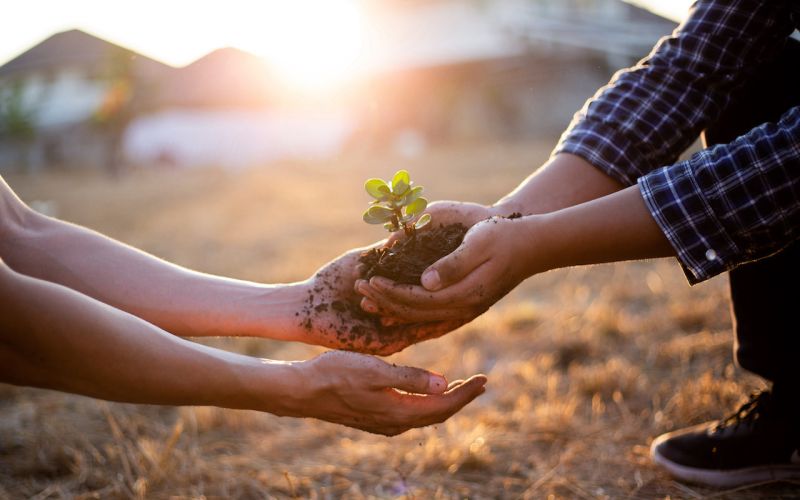Ecology
Redesigning our Agriculture is the first emergency against climate change

Our arable land is getting smaller and smaller and less and less productive. It will soon no longer be enough to feed humanity. During the last 100 years, one billion hectares of fertile land have disappeared: this represents more than 15 times the surface of France. In the World, soils sterilized by pollution cover some 220,000 km², including nearly 90% in Europe. Intensive agriculture is the main cause of this terrifying situation: the current model is an ecological aberration.
In France, more than 60% of farmers would generate a negative income without subsidies. The need to mechanize the production of increasingly large farms imposes on Professionals some investments that they will not be able to amortize. The use of chemical inputs and the resulting energy consumption also weigh on their expenses. The model is not economically profitable.
The destruction of the soil by Humans endangers their survival. Solutions exist but putting them in place is now crucial and will require the involvement of all to change our model of agriculture.
Soil destruction is reaching very worrying proportions.
Intensive agriculture is the cause of soil erosion, compaction, acidification, pollution, salinization and loss of nutrients and biodiversity. Each year, between 25 and 40 billion tons of fertile land, which constitutes the habitat of 80% of the biomass and regulates the carbon and nitrogen cycle, are washed away.
The main consequence of deep ploughing is that humus and nutrient levels in soils have dropped by a third since 1950. According to GisSol, this concerns 40% of French agricultural land. Soils are exhausted and their productivity is falling. After increasing until 1995, it is stagnating or regressing.
Erosion goes now faster than the process of soil formation. In Europe, erosion is degrading 33 million hectares, or 4% of arable land, increasing by 90,000 hectares per year.
Soil salinization is caused by overexploitation and the use of chemical pollutants. According to the FAO, man-made salinity affects 760,000 km² in the world. In North Africa, where the situation is most worrying, crop yields have dropped from 5 to 0.5 tons per hectare, generating an economic loss of more than one billion dollars.
Agriculture is the second largest emitter of greenhouse gases in France.
A 2019 report by the French Ministry of Ecological Transition indicates that Agriculture accounts for 19% of total emissions with 85 megatons of CO2. On a global scale, the proportion reaches 24% according to an IPCC report.
There is, however, one notable difference compared to other sectors of activity: the cause of emissions is not so much energy consumption as biological processes linked to our current way of producing.
The main problem is methane (CH4), mainly caused by the digestion of ruminants and thus by the cattle industry. Methane has a global warming potential (GWP) 25 times higher than CO2. However, it only persists in the atmosphere for a dozen years, compared to about a century for CO2. It is therefore possible to think that reducing our methane emissions would have a much faster impact on climate change than reducing CO2.
The second greenhouse gas caused by current agricultural activity is nitrous oxide (N2O), a consequence of the use of nitrogenous fertilizers. The origin of the emissions is linked to the fact that plants only absorb about 50% of the fertilizer applied to agricultural land, and release the rest. Agriculture accounts for two thirds of the emissions of N2O which has a global warming potential 300 times higher than CO2, and persists in the atmosphere at least as long, while being one of the main ozone depleting substances.
Finally, if we take the entire food value chain (production, transport, distribution, processing...), the share of greenhouse gas emissions in the French total rises to more than 30%, according to a recent report by Ademe.
Pollution lowers the nutritional quality of our food.
The University of Washington in Seattle conducted an experiment simulating the level of CO2 in the atmosphere by 2050, 568-590 parts per million compared to 400 today, on 18 different rice varieties.
This study published in May 2018 concludes a 10% decrease in the amount of iron, zinc, protein, and vitamins B1, B2, B5 and B9, which are necessary for our bodies to convert food into energy, in rice. The suspected cause is that CO2 increases the plant's carbohydrate level during photosynthesis, reducing proteins and minerals.
In Asia, about 70% of calories and most nutrients come from rice. By 2050, an additional 150 million people may be at risk of protein deficiency.
An American study in 2004 drew alarmist conclusions by stating that the loss of nutritional quality of our food was major and that, for example, an apple of today was 100 times less nutritious than an apple of the 1950s.
Since then, it has been widely demonstrated that this study had methodological and confirmatory biases and that the conclusions are subject to qualification.
In contrast, more recent studies have compared not fruits and vegetables, but seedlings. These studies have shown that several factors do have a negative effect on the nutritional quality of our food:
- · Since the 1960s, agricultural research has focused on the productivity of cultivars and the use of chemical fertilizers, resulting in a tenfold increase in yields of vegetables, fruits, and grains. The result is a "dilution effect": the increase in nutrient concentration is not proportional to the increase in yield
- · Soil degradation prevents plants from getting the nutrients they need. In spite of inputs (fertilizers, nitrogen, phosphorus, potassium...), the balance is not achieved, and the plants remain more vulnerable to diseases, have a slower growth and lose nutrients
- · The increase in atmospheric CO2 has a perverse effect: by accelerating the process of photosynthesis, it speeds up the growth of plants and therefore increases their yield. On the other hand, the nutritional value decreases: the plant stores more glucose, to the detriment of minerals such as iron or zinc
It is now accepted that if the trend of increasing greenhouse gas emissions continues, the iron content in wheat, soybeans, rice, and potatoes could decrease by 10% by 2050.
The current agriculture is bankrupt.
In 1950, it took 2.5 units of fossil energy to produce 1 unit of food. Today, it takes 13.
In 2016, subsidies represented 77% of the income of French farmers. That is 9 billion Euros. This ratio can even reach 90% in some productions specialized in dairy farming.
With the impact on the soil, and therefore on its production tool, agriculture is one of the only sectors of activity to have decapitalized in recent years. This system cannot mechanically be profitable.
At the same time, the increase in greenhouse gases is leading to an increase in the average temperature on Earth and causing extreme climatic phenomena. Farmers are the first victims. The planning of agricultural production is becoming more and more difficult, harvests are more and more often destroyed by bad weather, and the financial results of this sector of activity can only get worse.
There is also an impact on yields: 19% less on cereals between 2021 and 2020 and up to -30% on the grasslands used by the Breeders.
Already mechanically bankrupt, French agriculture is in a vicious circle that requires major changes.
The good news is that the soil destruction process is reversible.
Recent examples prove this.
In England, the Eden Project has reclaimed the dead soil of a former kaolin quarry to create an environmental complex including gardens.
Fermes d'Avenir has created an agroecological farm inspired by permaculture on a former air base near Paris.
The Ministry of Agriculture defines agroecology as "a way of designing production systems that rely on the functionalities offered by ecosystems (...) by using Nature as a production factor to the maximum, while maintaining its capacity for renewal".
For example, rehabilitating hedgerows would help maintain biodiversity by providing shelter for crop protection agents, contribute to carbon storage, fight against erosion, loosen soil by roots and ultimately increase crop yields.
Covering soils with legumes would improve the yield of the photosynthetic surface and fix nitrogen without the use of chemical inputs, while consuming the carbon removed from photosynthesis by crops.
Ensuring a real crop rotation by coupling it with grazing also helps photosynthesis while avoiding turning over the soil. This favors the development of organic matter and, ultimately, the storage of CO2.
Agroecology can change the economic equation.
Entrepreneurs are making sustainable agriculture profitable, using permaculture principles, reducing the size of plots, setting up short circuits and working to integrate the long-term unemployed.
Jardins de Cocagne and Fermes d'Avenir are examples among many others.
By avoiding chemical inputs and mechanization, costs become less important. By adopting short circuits, intermediaries are no longer necessary, and the producer's income increases. The accounts are balanced.
An experimental farm in the Eure French Department has been conducting studies since 2006. This farm has proven that by adopting the techniques of a more resilient and virtuous agriculture, a market gardener can generate the French legal minimum wage (SMIC) by manually cultivating a plot of only 1,000 m².
The solutions exist and are known.
The solutions are there but are still suffering from slow political decision-making and scaling up.
Research is increasingly tackling the subject of agroecology and more and more publications are available. The mobilization of agricultural stakeholders is increasingly strong to adapt production systems and diversify them.
Research and Farmers are starting to work together, and that's good news.
But it is also up to us, consumers, to adapt and change our habits to help this movement: we can buy more local, better quality, limiting ourselves to the necessary quantity, and adopt a more virtuous, more vegetarian, and healthier diet.
It is up to each of us to protect the Planet and to ensure the survival of our food production system.
By rethinking the way we eat, we can help our farmers to redefine their mode of production to make it more sustainable and above all, to make it last.
